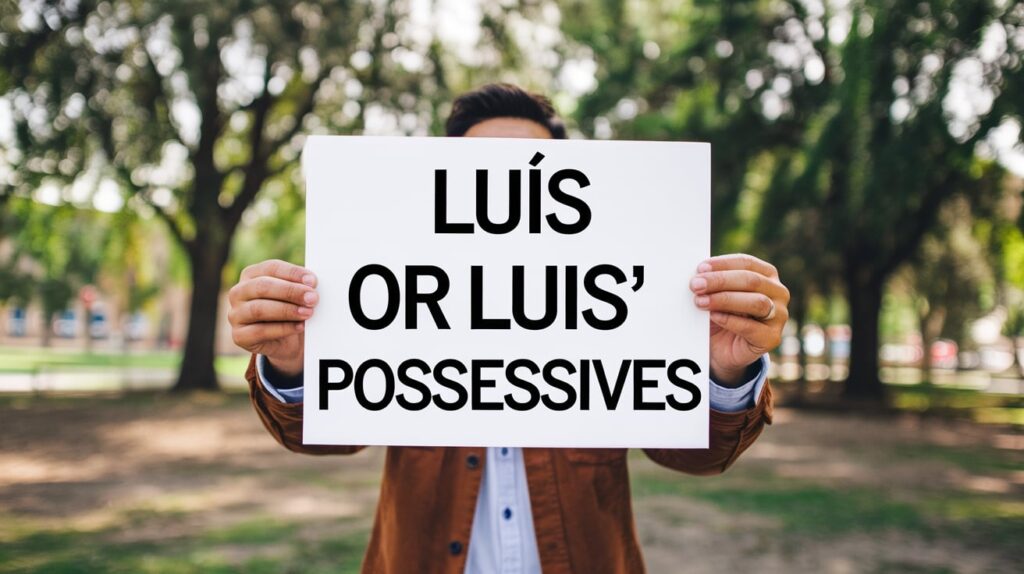English possessives can sometimes be confusing, particularly when it comes to names ending in “s.” The debate between using Luis’ or Luis’s possessives is a common point of contention.
In this article, we’ll dive deep into the rules and conventions that govern possessives for names ending in “s,” using Luis as a primary example. We’ll explore scenarios where both forms might be applicable, discuss stylistic
preferences, and provide clear examples to help you choose the correct possessive form for various contexts.

The Basics of Possessives
In English, possessives are used to indicate ownership or a relationship between entities. Generally, to form the possessive of a noun, you add an apostrophe followed by an “s.” For example:
John’s book means the book belonging to John.
The cat’s toy means the toy belonging to the cat.
However, names ending in “s” present a unique challenge. This is where we encounter the choice between Luis’ or Luis’s possessives.
Read more : Agreeance vs Agreement – Grammar Beacon
Standard Rules for Possessives
The standard rule for forming possessives with names ending in “s” is to add an apostrophe followed by an “s.” For instance:
James’s car (the car belonging to James)
Charles’s house (the house belonging to Charles)
This rule is straightforward and applies to most cases. However, some style guides and conventions prefer dropping the additional “s” after the apostrophe.
Read more : Scrapped vs Scraped – Grammar Beacon

The Debate: Luis’ or Luis’s possessives
When it comes to names ending in “s,” you’ll often see two styles: Luis’ and Luis’s. Let’s break down when each might be used and why.
Luis’ — The Simpler Approach
Luis’ is the simpler, often preferred form in many style guides. This form omits the extra “s” after the apostrophe. Here’s why it’s commonly used:
Clarity and Simplicity: For names with an “s” at the end, adding another “s” can feel cumbersome. The apostrophe alone is often seen as sufficient to indicate possession.
Example: Luis’ car (the car belonging to Luis)
Consistency: Some style guides, like the Associated Press (AP), prefer the singular apostrophe to avoid the awkwardness of double “s” sounds.
Example: Luis’ ideas (the ideas belonging to Luis)
Luis’s — The Traditional Approach
On the other hand, Luis’s follows the more traditional rule of adding an apostrophe and an “s” to the end of the name. This form is often used in more formal writing or by style guides like the Chicago Manual of Style.
Traditional Grammar Rules: The rule of adding ‘s after the apostrophe is rooted in historical grammar conventions and is often preferred in academic and formal writing.
Example: Luis’s book (the book belonging to Luis)
Consistency with Other Possessives: Some prefer this form to keep possessive forms consistent, especially in complex sentences or academic contexts.
Example: Luis’s contributions (the contributions made by Luis)
Read more : Story’s or Stories possessives – Grammar Beacon

Examples of Both Forms in Use
To clarify the application of Luis’ or Luis’s possessives, let’s look at various scenarios where both forms might be used:
Personal Possessions
When referring to personal items or belongings:
Luis’: Luis’ jacket is stylish and warm. (This form simplifies the possessive for casual contexts.)
Luis’s: Luis’s jacket is stylish and warm. (This form maintains traditional grammar rules.)
Read more : Story’s or Stories possessives – Grammar Beacon

Collective Works
When discussing collective works or achievements:
Luis’: Luis’ achievements are noteworthy. (Here, the simpler possessive form might be used in informal writing.)
Luis’s: Luis’s achievements are noteworthy. (This form emphasizes adherence to traditional grammar.)
Formal Writing
In formal or academic contexts, the use of Luis’s is more common:
Luis’s research has been groundbreaking. (This aligns with formal conventions and ensures clarity.)
Stylistic Preferences
Different style guides offer various recommendations for possessives with names ending in “s.” It’s essential to be consistent with the chosen style throughout your document.
AP Style: Generally prefers Luis’ for simplicity.
Chicago Manual of Style: Advocates for Luis’s to follow traditional possessive rules.
Read more : “Totalling” vs. “Totaling”: Navigating the Spelling Dilemma – Grammar Beacon
How to Choose Between Luis’ and Luis’s
When deciding whether to use Luis’ or Luis’s, consider the following:
Audience and Context: For formal writing or academic papers, go with Luis’s. For informal writing or when adhering to AP style, Luis’ is acceptable.
Consistency: Whichever form you choose, ensure consistency throughout your text to maintain clarity and professionalism.
Practical Scenarios
Scenario 1: Informal Note
In an informal note or message, you might write:
Luis’: Luis’ meeting notes were very helpful.
This form keeps the note casual and straightforward.
Scenario 2: Academic Paper
In an academic paper, you’d likely use:
Luis’s: Luis’s study provides significant insights into the topic.
The traditional form aligns with formal writing conventions.
Read more : Other Ways to Say Thank You For Responding Quickly – Grammar Beacon
Conclusion
Choosing between Luis’ and Luis’s ultimately depends on your audience, context, and personal or institutional style preferences. Luis’ tends to be simpler and is often preferred in casual or journalistic contexts,
while Luis’s follows traditional grammar rules and is common in formal writing.
Remember, whichever form you choose, consistency is key. Be sure to apply the same possessive rule throughout your text to ensure clarity and professionalism.
Understanding these nuances will help you write more effectively and confidently, whether you’re drafting an informal note or a formal research paper.
Table of Singular, Plural, Singular Possessive, and Plural Possessive Forms
Here’s a detailed table that shows the forms for singular and plural nouns, as well as their possessive forms:
| Noun Type | Singular | Plural | Singular Possessive | Plural Possessive |
| Regular Nouns | Dog | Dogs | Dog’s | Dogs’ |
| Irregular Nouns | Child | Children | Child’s | Children’s |
| Names Ending in S | James | Jameses | James’s | Jameses’ |
| Names Not Ending in S | Luis | Luises | Luis’s | Luises’ |
| Compound Nouns | Mother-in-law | Mothers-in-law | Mother-in-law’s | Mothers-in-law’s |
| Uncountable Nouns | Information | Information | Information’s | (N/A) |
Explanation:
Regular Nouns: For regular nouns, the singular possessive is formed by adding ‘s to the end of the singular form. The plural possessive is formed by adding ‘ after the plural form.
Irregular Nouns: For irregular nouns like “child,” the plural form is not created by simply adding ‘s. Instead, it’s an entirely different word (“children”), and the possessive forms are similarly irregular.
Names Ending in S: For names ending in “s,” there are two main approaches: adding ‘s or just an apostrophe. The choice often depends on style preference. For example, Luis’s vs. Luis’.
Compound Nouns: For compound nouns, the possessive is typically applied to the last word in the compound. For example, mother-in-law’s.
Uncountable Nouns: Uncountable nouns like “information” don’t have a plural form, so their possessive form is the same as the singular possessive.

James Logan is a seasoned blogger and language enthusiast behind Grammar Beacon. With years of experience in grammar and writing, James shares his expertise through insightful and engaging content. His passion for clear communication and linguistic precision shines in every post, making complex grammar concepts accessible and enjoyable for readers. Follow James for expert advice and tips to refine your writing skills.







